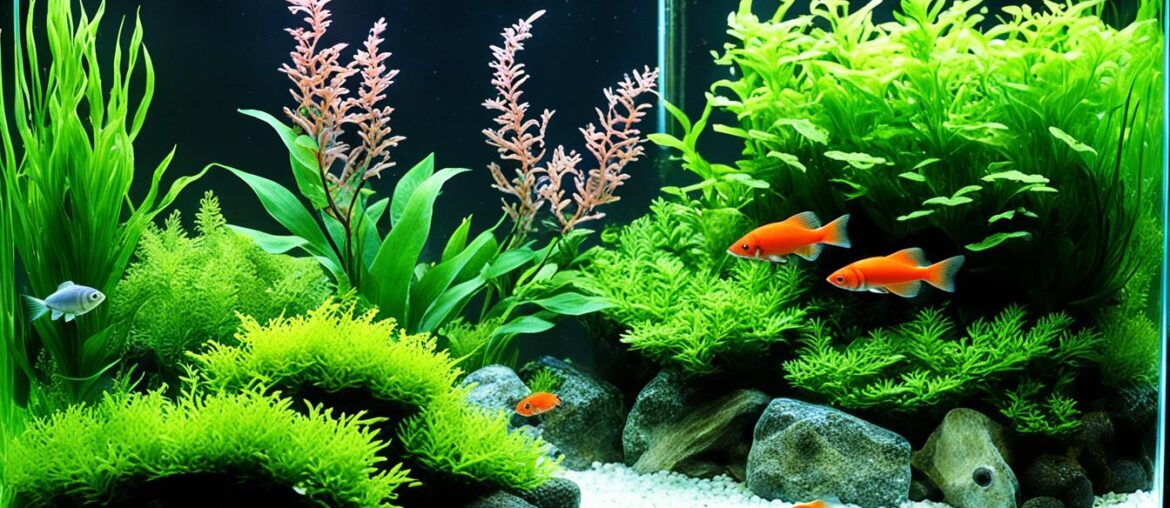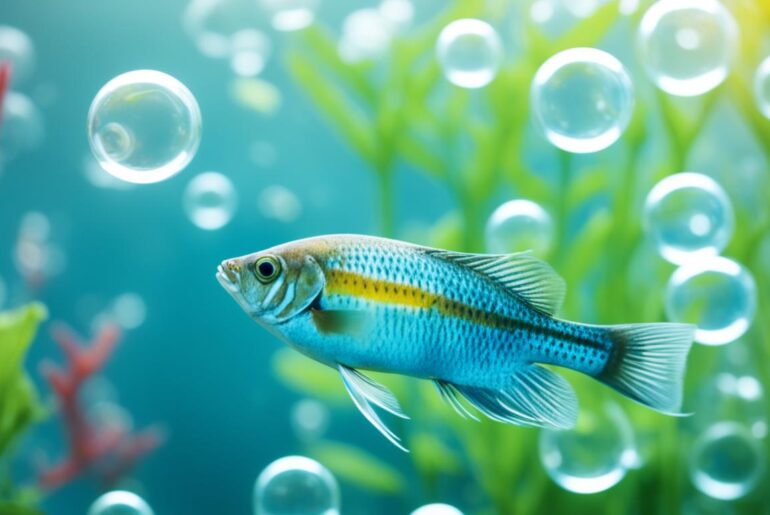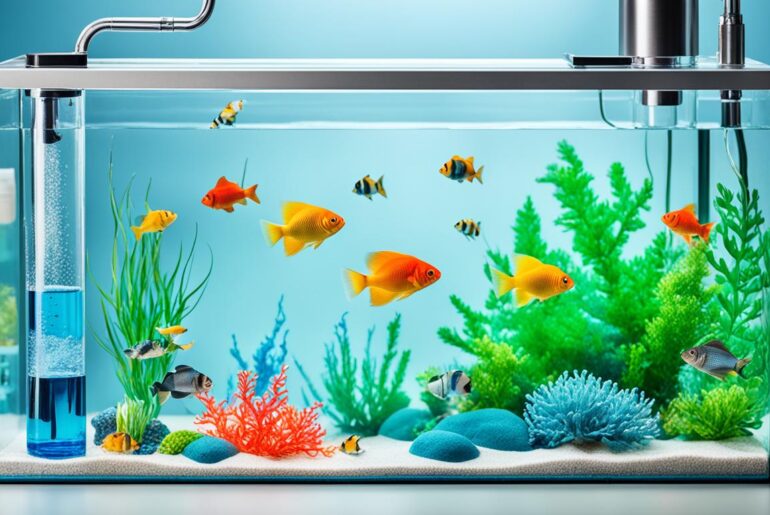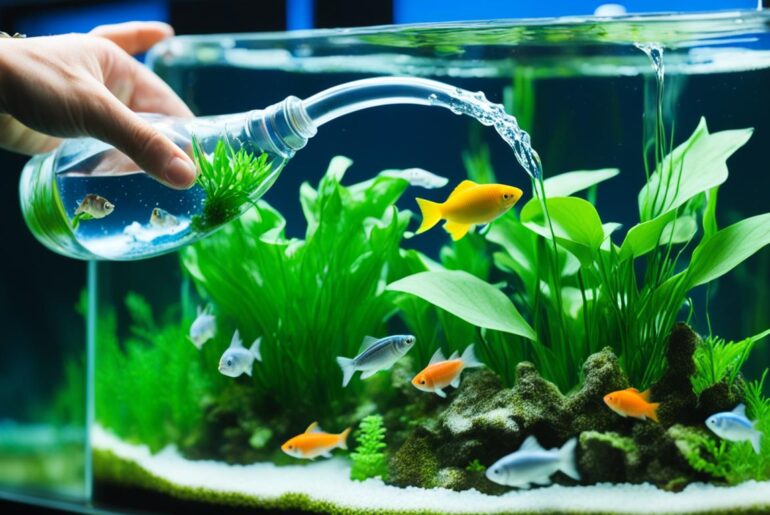Have you ever wanted to bring the beauty of an underwater world into your home? That was my dream when I decided to set up a small freshwater aquarium in my living room. Little did I know, the journey to creating a thriving aquatic ecosystem would be filled with challenges and lessons.
I began by researching the basics of aquarium setup and maintenance. One crucial step that stood out to me was the process of cycling a freshwater aquarium. It’s a vital process that establishes a healthy environment for the fish, ensuring their well-being and longevity. Intrigued, I delved deeper into the world of aquarium cycling, eager to provide the best possible home for my aquatic friends.
Through trial and error, I learned the three key steps to successfully cycling a small freshwater aquarium. These steps transformed my aquarium from a lifeless tank to a vibrant underwater paradise, and I want to share my knowledge and experiences with you.
Join me as I guide you through the fascinating world of aquarium cycling. Together, we’ll explore the importance of this process, discover different methods to cycle your aquarium, and learn essential tips and tricks for maintaining a healthy and thriving ecosystem for your fish.
Key Takeaways:
- Learn the three key steps to successfully cycling a small freshwater aquarium
- Understand the importance of aquarium cycling for the health and well-being of your fish
- Discover different methods to cycle your aquarium, including fishless and fish-in cycling
- Explore the benefits of cycling an aquarium with plants
- Gain essential tips and tricks for maintaining a thriving aquatic ecosystem
What is Aquarium Cycling?
Aquarium cycling is the process of creating a biologically safe environment for fish in a new tank. It involves introducing nitrifying bacteria into the aquarium to regulate the nitrogen cycle. These bacteria help break down fish waste and convert ammonia to nitrite, and eventually to nitrate.
| Key Points: | Details: |
|---|---|
| Aquarium cycling | The process of creating a biologically safe environment for fish in a new tank |
| Nitrogen cycle | The chemical process that converts fish waste into less harmful substances through the action of nitrifying bacteria |
| Nitrifying bacteria | Bacteria that convert toxic ammonia produced by fish waste into nitrite and then nitrate |
The nitrogen cycle is a vital process in maintaining a healthy aquarium. By establishing a balanced population of nitrifying bacteria, you can ensure that ammonia, a toxic substance for fish, is effectively converted into less harmful compounds. This cycle helps maintain water quality and provides a safe and stable environment for your fish to thrive.
“Aquarium cycling is the foundation of a healthy aquatic habitat. By understanding the nitrogen cycle and the importance of nitrifying bacteria, you can create a flourishing environment for your fish.”
Why is Aquarium Cycling Important?
When it comes to setting up a new aquarium, aquarium cycling is a crucial step that should not be overlooked. By cycling your aquarium, you allow beneficial bacteria to establish themselves in the tank before introducing fish. This process is essential for creating a suitable and stable environment for your aquatic pets to thrive.
If an aquarium is not properly cycled, fish can be exposed to high levels of ammonia and other toxins, leading to a condition known as New Tank Syndrome. This can be harmful and even fatal to the fish in your tank. By cycling your aquarium, you significantly reduce the risk of New Tank Syndrome and create a healthier habitat for your fish.
“Cycling your aquarium is like laying the foundation for a strong and healthy ecosystem. It’s the first important step towards creating a thriving aquatic environment.”
Cycling your aquarium promotes the growth of nitrifying bacteria, which play a vital role in the nitrogen cycle. These bacteria help break down fish waste and convert ammonia to nitrite, and eventually to nitrate. Nitrate is less harmful to fish in low levels and can be managed through regular water changes.
By establishing a healthy nitrogen cycle through aquarium cycling, you can maintain optimal water conditions and prevent the buildup of harmful substances in your tank. This ultimately contributes to the overall well-being of your fish and other aquatic inhabitants.
The Dangers of New Tank Syndrome
New Tank Syndrome can occur when a new aquarium is not properly cycled. During this condition, fish may become stressed, exhibit unusual behavior, or even die due to exposure to high levels of ammonia and other toxins. It is essential to prevent New Tank Syndrome by cycling your aquarium before introducing any fish.
Here are a few symptoms that may indicate the presence of New Tank Syndrome:
- Fish gasping for air at the water surface
- Unexplained fish deaths
- Cloudy or murky water
- Ammonia or nitrite spikes
If you suspect New Tank Syndrome in your aquarium, it is crucial to take immediate action. Perform a water test to check ammonia and nitrite levels, and consider partially or fully draining and cycling your aquarium again.
A well-cycled aquarium is less likely to experience such harmful conditions and ensures a healthier environment for your fish to flourish.
How Long Does Aquarium Cycling Take?
The duration of aquarium cycling can vary depending on several factors. Generally, it takes four to eight weeks to complete the cycling process. However, it’s important to note that individual tanks may cycle at different rates.
Tank Size: The size of your aquarium can affect the duration of the cycling process. Larger tanks typically take longer to cycle compared to smaller ones. This is because a larger volume of water requires more time for the beneficial bacteria to establish and regulate the nitrogen cycle.
Water pH: The pH level of your tank’s water can also impact the cycling time. Some species of nitrifying bacteria thrive in specific pH ranges. If the water pH is not within the ideal range for these bacteria, the cycling process may take longer.
Temperature: The temperature of the aquarium water can influence the speed of the cycling process. Warmer temperatures generally facilitate faster bacterial growth and metabolic activity, accelerating the cycling time. Conversely, cooler temperatures may slow down the bacteria’s growth and prolong the cycling process.
Monitoring Levels: To determine when the cycling process is complete, it’s essential to monitor the levels of ammonia, nitrite, and nitrate in your tank. You can use an aquarium test kit to regularly test these parameters. Once ammonia and nitrite levels consistently read zero, and nitrates are being produced, it signifies that the cycle is complete.
“Monitoring ammonia, nitrite, and nitrate levels throughout the cycling process is crucial in ensuring the establishment of a healthy aquatic ecosystem.”
Factors Affecting Aquarium Cycling Time
| Factors | Impact on Cycling Time |
|---|---|
| Tank Size | Larger tanks generally take longer to cycle compared to smaller ones. |
| Water pH | The pH level of the water can influence the duration of the cycling process. |
| Temperature | Warmer temperatures accelerate bacterial growth, while cooler temperatures may slow it down. |
| Monitoring Levels | Regularly testing ammonia, nitrite, and nitrate levels helps determine when the cycle is complete. |
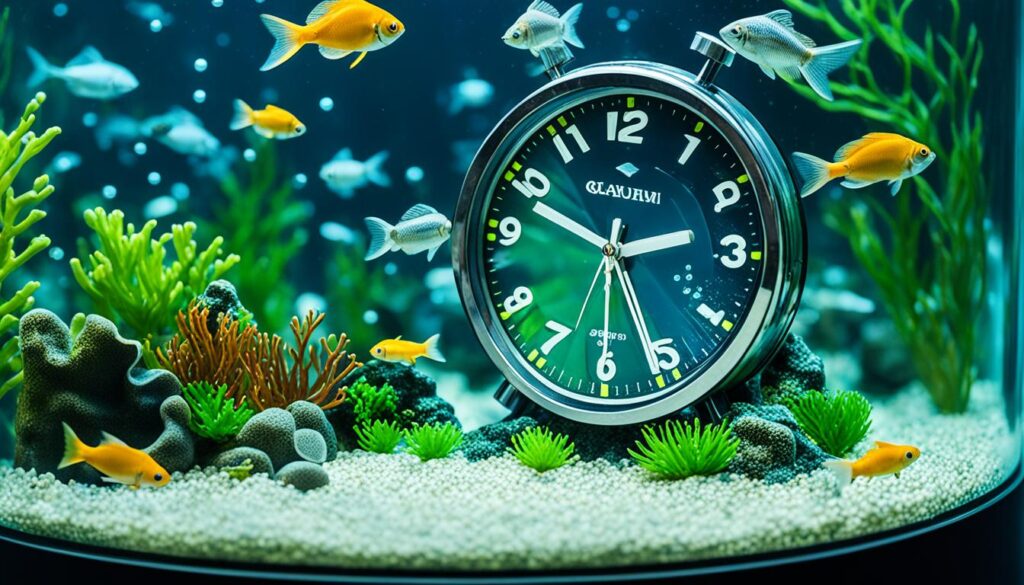
Items Needed to Cycle an Aquarium
Cycling an aquarium is an essential process in preparing a healthy habitat for your fish. Before you start the cycling process, it’s important to gather all the necessary items to ensure a successful cycle. Here is a checklist of items needed for aquarium cycling:
- Fish food
- Aquarium test kit
- Tank components (pumps, filters, substrate)
- A quality water filter
By having these items ready, you can efficiently monitor and maintain the cycling process, providing the optimal conditions for establishing a stable nitrogen cycle in your aquarium.
Pro Tip: Choosing a reliable aquarium test kit is crucial in monitoring ammonia, nitrite, and nitrate levels, allowing you to track the progress of the cycling process effectively.
| Items Needed | Description |
|---|---|
| Fish food | Provides ammonia source for establishing beneficial bacteria |
| Aquarium test kit | Allows monitoring of ammonia, nitrite, and nitrate levels |
| Tank components | Includes pumps, filters, and substrate for maintaining water quality |
| Quality water filter | Ensures effective filtration and removal of impurities |
Why are these items necessary?
Fish food serves as a source of ammonia during the cycling process. The beneficial bacteria in the aquarium break down the fish food, producing ammonia, which is an essential component of the nitrogen cycle. An aquarium test kit is essential for monitoring ammonia, nitrite, and nitrate levels, allowing you to track the progress of the cycling process and ensure the tank’s conditions are suitable for fish. Tank components such as pumps, filters, and substrate provide the necessary tools for maintaining water quality, ensuring proper aeration, filtration, and a suitable environment for beneficial bacteria to thrive. Finally, a quality water filter helps remove impurities and maintain a cleaner and healthier aquarium.
Cycling an Aquarium Without Fish
When it comes to cycling an aquarium, there is a more humane and popular method that doesn’t involve subjecting fish to potential harm. Fishless aquarium cycling is a safe and effective way to establish a healthy environment for your aquatic friends. Here’s how you can successfully cycle your aquarium without fish:
- Set up the tank: Before starting the cycling process, make sure you have all the necessary components set up in your aquarium, including pumps, filters, and substrate. This will provide the optimal conditions for the cycling to occur.
- Check the water pH: Test the pH of your water using a reliable aquarium test kit. This will ensure that the water is within the suitable range for nitrifying bacteria to thrive.
- Add ammonia to the tank: To simulate the presence of fish waste, you can add ammonia to your aquarium. This can be done by using fish food, which will gradually release ammonia as it decomposes. Start with a small amount and adjust as necessary to maintain the desired levels.
- Monitor ammonia and nitrite levels: Regularly test the water for ammonia and nitrite levels using your aquarium test kit. During the cycling process, you’ll notice a spike in both ammonia and nitrite levels. As the nitrifying bacteria establish themselves, these levels will gradually decrease.
- Complete the cycling process: The cycling process is complete when both ammonia and nitrite levels drop to zero and nitrate levels start to rise. This indicates that the beneficial bacteria have successfully colonized your aquarium and are converting harmful toxins into less harmful nitrate.
By cycling your aquarium without fish, you give the beneficial bacteria the time they need to establish themselves and ensure a healthy nitrogen cycle. This method also eliminates the risk of subjecting fish to high ammonia or nitrite levels, providing a safer and more humane environment for your aquatic pets.
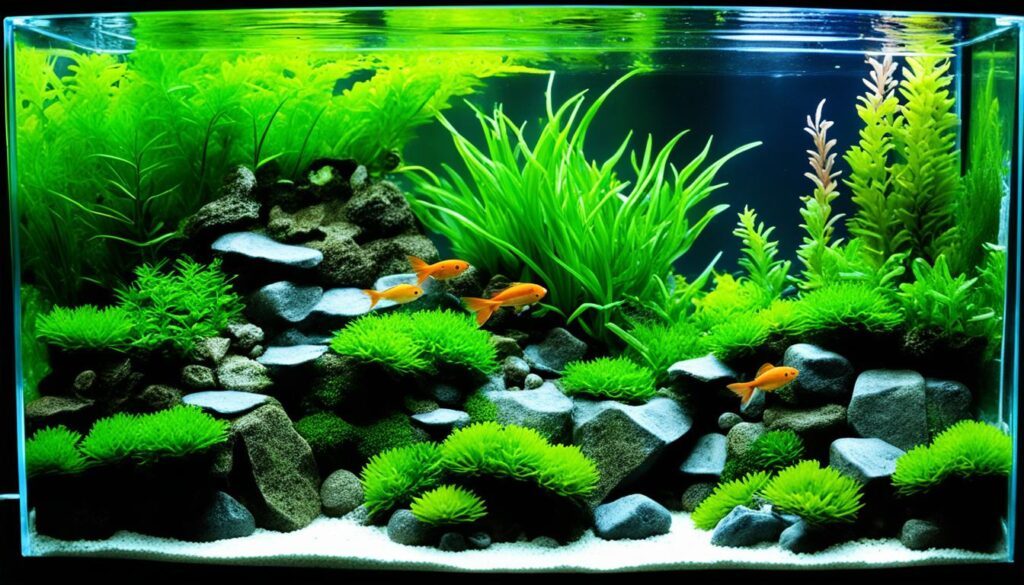
Cycling an Aquarium With Fish
Cycling an aquarium with fish is another method for establishing a healthy tank environment. By adding a few hardy fish from the start, you can help kickstart the cycling process. These fish are capable of withstanding the initial high levels of ammonia and nitrites, making them ideal for this method.
To ensure the well-being of the fish during cycling, it is important to feed them sparingly. Excessive feeding can lead to increased ammonia levels, which can be harmful to the fish. Instead, provide small, regular meals to prevent ammonia spikes.
Frequent water changes are crucial when cycling your aquarium with fish. Regular water changes help maintain water quality by reducing the build-up of toxins. Aim to perform a 10-20% water change once or twice a week, depending on the ammonia and nitrite levels in the tank.
Remember, the health and well-being of your fish should be a top priority during the cycling process. Taking the necessary steps to minimize ammonia and nitrite levels through regular water changes and proper feeding will go a long way in creating a safe and thriving environment for your fish.
Recommended Hardy Fish for Cycling:
- Guppy
- Zebra Danio
- Platy
- White Cloud Mountain Minnow
- Bristlenose Pleco
Hardy fish species, like the ones listed above, can tolerate fluctuations in water parameters and are resilient to the cycling process. However, it is still essential to monitor ammonia and nitrite levels regularly using a reliable aquarium test kit.
| Fish Species | Tolerance to Cycling | Recommended Tank Size |
|---|---|---|
| Guppy | High | 10 gallons or more |
| Zebra Danio | High | 15 gallons or more |
| Platy | Moderate | 10 gallons or more |
| White Cloud Mountain Minnow | High | 10 gallons or more |
| Bristlenose Pleco | Moderate | 20 gallons or more |
During the cycling process, it is important to observe the behavior and appearance of your fish. If you notice any signs of distress, such as rapid breathing, loss of appetite, or unusual swimming patterns, it may indicate a problem with water quality. In such cases, perform an immediate water change and seek the advice of an aquarium professional.
Once the cycling process is complete, and ammonia and nitrite levels have dropped to zero, you can gradually introduce more fish to your aquarium. However, remember to research the specific care requirements of each fish species and ensure they are compatible with your existing fish.
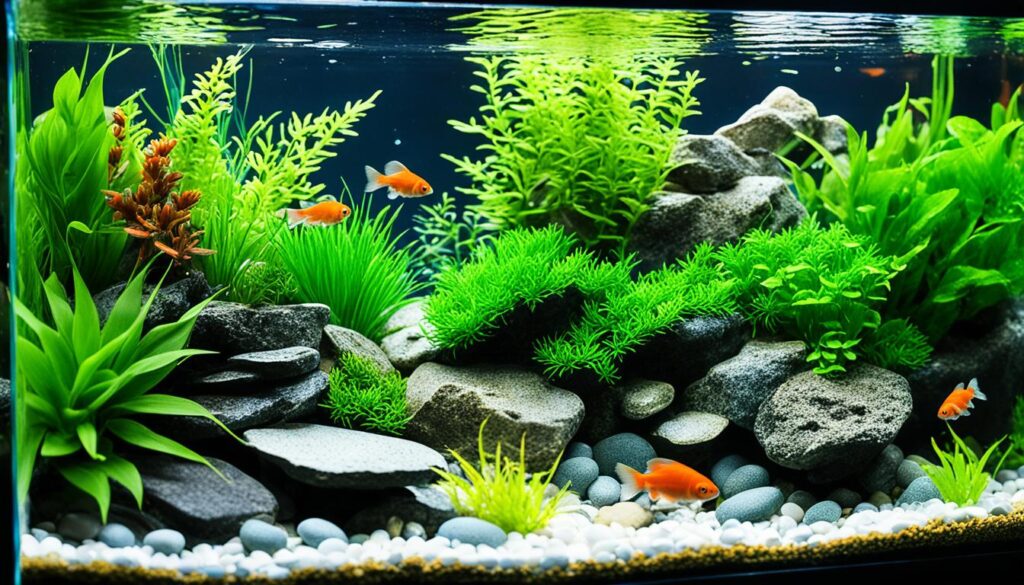
Cycling an Aquarium With Plants
When it comes to cycling an aquarium, incorporating plants can bring a natural and visually appealing touch to your tank. Not only do aquatic plants enhance the aesthetics of the aquarium, but they also play a vital role in the cycling process by helping to consume nitrogen waste.
Aquatic plants absorb ammonia and nitrates from the water, utilizing them as nutrients for growth. This natural process assists in reducing the levels of harmful nitrogen compounds in the aquarium, promoting a healthier environment for your fish.
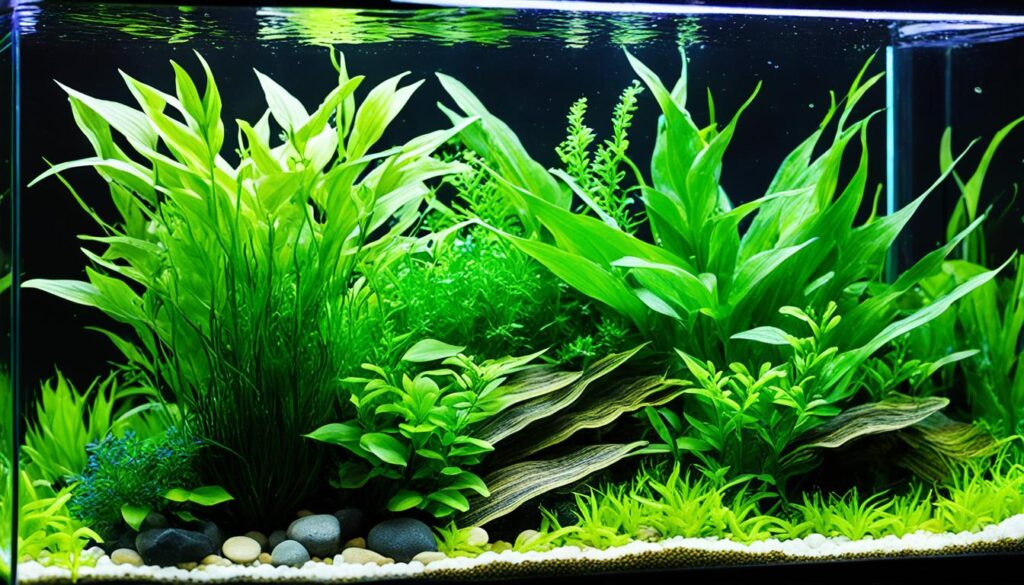
Once you’ve introduced the plants into your aquarium, you can monitor their progress by observing new growth and healthy leaves. This indicates that the plants are actively consuming ammonia and nitrates, contributing to the cycling process.
As the nitrogen waste is effectively processed by the plants, the aquarium’s water quality improves, making it suitable for introducing fish. It is important to note that the cycling process may take several weeks to complete, and patience is key during this time.
Gradually adding fish to a cycled aquarium with plants ensures a smoother transition for them, as the plants help maintain a stable and balanced ecosystem. Remember to select fish species that are compatible with the plants and can thrive in the specific conditions of your tank.
Cycling an aquarium with plants is not only beneficial for the overall health of your fish but also provides an aesthetically pleasing and vibrant underwater environment. So, consider incorporating live aquatic plants into your aquarium for a more natural and beautiful cycling process.
Conclusion
Cycling a small freshwater aquarium is an essential step in ensuring the health and well-being of your fish. Whether you choose to cycle with or without fish, or with plants, it is crucial to monitor ammonia, nitrite, and nitrate levels throughout the process. This will help you create a safe and thriving environment for your fish.
To successfully cycle your small freshwater aquarium, start by setting up all the necessary tank components and ensuring a proper water filter system. Whether you opt for fishless cycling or cycling with fish, make sure to feed sparingly and perform regular water changes to maintain water quality.
Cycling an aquarium with plants can provide a more natural and visually appealing option. As the plants grow and absorb ammonia and nitrates, the cycling process is completed. Gradually introducing fish to the tank will help establish a harmonious ecosystem.
By following the steps outlined in this article, you can achieve a well-cycled small freshwater aquarium, promoting the health and happiness of your fish. Remember to be patient, as the cycling process usually takes several weeks. Your efforts will be rewarded with a beautiful and thriving underwater habitat for your aquatic companions.
FAQ
What is aquarium cycling?
Aquarium cycling is the process of creating a biologically safe environment for fish in a new tank. It involves introducing nitrifying bacteria into the aquarium to regulate the nitrogen cycle.
Why is aquarium cycling important?
Aquarium cycling is important because it allows beneficial bacteria to establish themselves in the tank before introducing fish. This helps create a suitable and stable environment for the fish to thrive and prevents New Tank Syndrome.
How long does aquarium cycling take?
The duration of aquarium cycling can vary but generally takes four to eight weeks. Factors such as tank size, water pH, and temperature can impact the cycling process. Monitoring ammonia, nitrite, and nitrate levels can help determine when the cycle is complete.
What items are needed to cycle an aquarium?
To cycle an aquarium, you will need fish food, an aquarium test kit, all necessary tank components such as pumps, filters, and substrate, and a quality water filter.
How do I cycle an aquarium without fish?
To cycle an aquarium without fish, you will need to set up the tank’s components, check the water pH, add ammonia to the tank using fish food, and monitor ammonia and nitrite levels. Once the levels drop to zero and nitrate is being produced, the cycling process is complete.
How do I cycle an aquarium with fish?
Cycling an aquarium with fish involves adding a few hardy fish to the tank from the start. These fish can tolerate the initial high levels of ammonia and nitrites. It is important to feed the fish sparingly and perform frequent water changes to maintain water quality during the cycling process.
Can I cycle an aquarium with plants?
Yes, cycling an aquarium with plants is possible. Aquatic plants help consume nitrogen waste and contribute to the cycling process. Once the plants show new growth and absorb ammonia and nitrates, the cycling process is complete, and fish can gradually be added to the tank.
What is the importance of cycling a small freshwater aquarium?
Cycling a small freshwater aquarium is essential in creating a healthy environment for your fish. It establishes a proper nitrogen cycle and allows beneficial bacteria to establish themselves, ensuring the fish are not exposed to high levels of toxins.
Should I monitor ammonia, nitrite, and nitrate levels during the cycling process?
Yes, monitoring ammonia, nitrite, and nitrate levels is crucial during the cycling process. It helps determine when the cycle is complete and ensures that the water quality remains safe for the fish.
